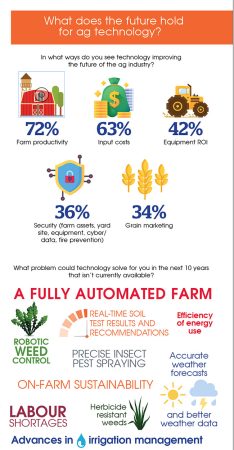
Uncategorized
AG Tech
Cultivating Innovation: What does the future hold – and how do we get there?
June 1, 2022 By Top Crop Manager
 PHOTO courtesy of baranq/ADOBE STOCK.
PHOTO courtesy of baranq/ADOBE STOCK. Technology has enormous potential to change the way Canadian farms operate in the future. Advancements in ag tech have already impacted Canadian farmers in myriad ways, and although it would be naïve to think technology could provide a solution to every problem, there’s always room for more improvement.
Toward the end of the Ag Tech Survey, respondents were asked what problem technology (not currently available in the market) could solve within the next 10 years. The results were varied, with some general themes of accuracy, autonomy, reliability and labour appearing several times throughout.
More than 70 per cent of respondents indicated technology could improve farm productivity, and 63 per cent specified input costs, with some of the comments providing more context: technology could improve the farm’s ROI by providing more accurate data collection, mitigating labour shortages and generally allowing farms to produce more bushels with fewer resources and acres to work with. Improved sensory technology to make more accurate applications of weed and insect pest control products was also noted several times.
Darcy Herauf, director, FCC Ag Expert, echoes these thoughts: “I’m watching the crop protection space and using different products . . . that help us make more use of our available nutrients or spray less [or more precisely],” he says. “I’m really looking forward to seeing what is available for farms to use less nutrients and grow the same or more bushels. I don’t think there’s any farm interested in growing less.”
When looking into barriers to implementing new technology on the farm [see pages 8 and 9 of this report], a lack of reliable high-speed internet and lack of service in rural areas didn’t place near the top of the list, at 19 per cent and 20 per cent respectively. However, for farms to capitalize on what’s currently available and successfully implement technology going forward, Alex Melnitchouck, chief technology officer, digital ag at Olds College, says rural connectivity needs to be improved.
 “There are many rural areas where you leave the highway and even cell phone coverage is not available,” he says. “Once we are able to connect to high-speed internet in every part of the field, that will be a completely different story . . . that will [bring] massive opportunities for various sensor applications, Internet of Things, autonomous equipment, data transfer and so on.”
“There are many rural areas where you leave the highway and even cell phone coverage is not available,” he says. “Once we are able to connect to high-speed internet in every part of the field, that will be a completely different story . . . that will [bring] massive opportunities for various sensor applications, Internet of Things, autonomous equipment, data transfer and so on.”
“Rural connectivity is necessary to make most of these technologies work. The world is talking about 5G, and I’m trying to get two bars of service at the farm on my cell phone,” Herauf adds.
“Maybe an aspect [to help support connectivity] is a role for government and telecommunications to work together,” adds Kerry Wright, CEO, CAAIN, noting that business opportunities will be delayed or lost if there’s a lack of connectivity in the industry.
“Streamlining and automating existing technologies is still an opportunity. Navigation, autosteer . . . these were almost immediately accepted by the industry because [they were] very easy,” Melnitchouck adds.
From valuable insights and organizational benefits to the significant mitigation of challenges, the future of ag tech is bright. But, as one survey respondent pointed out, it’s more important than ever to remember that technology “is just a tool in the tool box.”
Watch: What does the future hold for ag tech?